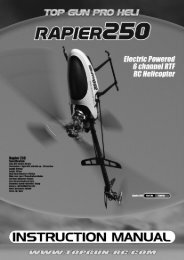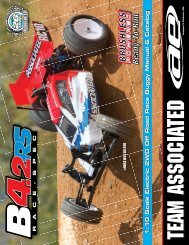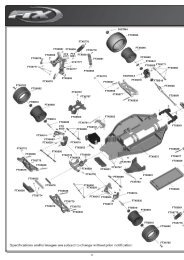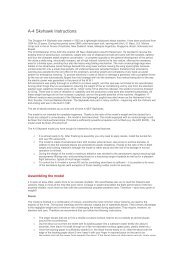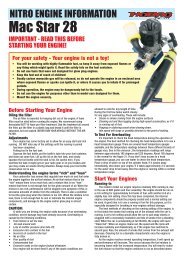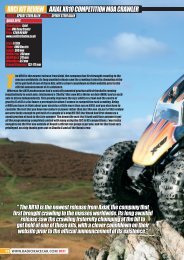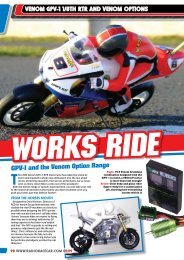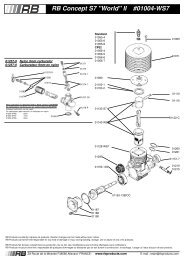rtf model - CML Distribution
rtf model - CML Distribution
rtf model - CML Distribution
Create successful ePaper yourself
Turn your PDF publications into a flip-book with our unique Google optimized e-Paper software.
IMPORTANT SAFETY INSTRUCTIONS AND WARNINGS – READ BEFORE USE<br />
• Lithium Polymer batteries can be volatile. Whilst some of the instances listed below are rare, they can occur and it is<br />
important for you to be aware of how to handle such situations. Failure to read and follow the below instructions may<br />
result in fire, personal injury and damage to property if charged or used improperly.<br />
• Top Gun Park Flite, its distributors or retailers assume no liability for failures to comply with these warnings and safety<br />
guidelines.<br />
• By using this battery, the buyer assumes all risks associated with lithium batteries. If you do not agree with these<br />
conditions, return the battery immediately before use.<br />
• The final use and preparation of the battery pack is ultimately beyond our control and those of our representatives and<br />
retaillers. Your decision to use this product incorporates your agreement that you have read and understood the safety<br />
precautions listed below and on each battery pack, and that you agree to accept full responsibility for any injury, loss or<br />
damage resulting from all circumstances surrounding your use or misuse of this product.<br />
GENERAL GUIDELINES AND WARNINGS<br />
1) Only use the supplied specific Lithium Polymer charger. Do not use a NiMH or NiCd charger - Failure to do so may a cause fire, which<br />
may result in personal injury and property damage.<br />
2) Never charge batteries unattended. When charging LiPo batteries you should always remain in constant observation to monitor the<br />
charging process and react to potential problems that may occur.<br />
4) If at any time you witness a battery starting to balloon or swell up, discontinue charging process immediately, disconnect the battery<br />
and observe it in a safe place for approximately 15 minutes. This may cause the battery to leak, and the reaction with air may cause the<br />
chemicals to ignite, resulting in fire.<br />
5) Since delayed chemical reaction can occur, it is best to observe the battery as a safety precaution. Battery observation should occur in a<br />
safe area outside of any building or vehicle and away from any combustible material.<br />
6) Wire lead shorts can cause fire! If you accidentally short the wires, the battery must be placed in a safe area for observation for<br />
approximately 15 minutes. Additionally, if a short occurs and contact is made with metal (such as rings on your hand), severe injuries<br />
may occur due to the conductibility of electric current.<br />
7) A battery can still ignite even after 10 minutes.<br />
8) In the event of a crash, you must remove battery for observation and place in a safe open area away from any combustible material for<br />
approximately 15 minutes.<br />
11) Never store or charge battery pack inside your car in extreme temperatures, since extreme temperature could ignite fire.<br />
CHARGING PROCESS<br />
1) Never charge batteries unattended.<br />
2) Charge in an isolated area, away from any flammable materials and inside a closed tin or lipo charge sack. In the unlikely event that the<br />
battery may fail and ignite, this procedure will ensure that a possible battery fire is contained and limiting any possible damage.<br />
3) Let battery cool down to ambient temperature before charging.<br />
DISCHARGE<br />
Ensure that you adhere to the warning beeps on your transmitter and land the <strong>model</strong> accordingly. Do not fly until the battery is completely<br />
discharged as damage will occur.<br />
STORAGE & TRANSPORTATION<br />
1) Store battery at room temperature between 40 and 80 degrees F for best results.<br />
2) Do not expose battery pack to direct sunlight (heat) for extended periods.<br />
3) When transporting or temporarily storing in a vehicle, temperature range should be greater than 20 degrees F but no more than 150<br />
degrees F.<br />
4) Storing battery at temperatures greater than 170 degrees F for extended periods of time (more than 2 hours) may cause damage to<br />
battery and possible fire.<br />
BATTERY LIFE<br />
Batteries that lose 20% of their capacity must be removed from service and disposed of properly. Discharge the battery to 3V/Cell, making sure<br />
output wires are insulated, then wrap battery in a bag for disposal.<br />
PRODUCT WARRANTY<br />
Product warranty is limited to original defects in material and workmanship. Warranty does not cover collateral damage. Due to the nature and<br />
use of the battery there is no term warranty. Misuse, abuse, incorrect charging and other inappropriate use of this product are not covered<br />
under warranty.<br />
14




